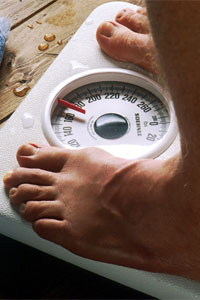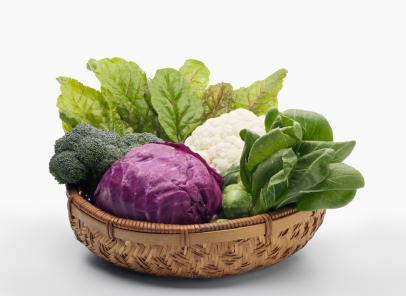Insulin Resistance and Weight Gain
Is your Growing Abdomen a Sign of Bigger Health Issues?
Interviewer: Gail Edgell
Gail Edgell: What exactly is insulin resistance, and how does it function in the body?
Dr. Boham: Insulin is a very important hormone that helps the body maintain a normal blood-sugar level. After we eat a meal and blood sugar goes up, the pancreas makes insulin. That insulin signals the cells to absorb that sugar and bring the blood sugar down to a good range. Our bodies work best when blood sugar is from 70 to 100 milligrams per deciliter.
Gail Edgell: Why do people actually become insulin-resistant all of a sudden? Does it happen over time? What happens to their bodies?
Dr. Boham: We think that insulin resistance is something that usually takes years to develop. It usually occurs for many reasons. We are choosing foods that are nutrient-poor, meaning that the foods have calories but not enough of certain nutrients that help the receptors in our bodies work best. We see that with processed foods and foods that are high in trans fat and hydrogenated fat. We also know that we can have insulin resistance when we are not getting enough fiber in our diets. The blood sugar shoots up too high after a meal, and our bodies have to make more insulin to keep the blood sugar in the normal range. Over time, our bodies get tired. If we eat a lot of refined, processed foods, it’s a lot of work for our bodies because the blood sugar is always going up so quickly.
Getting too much sugar in our diets, both regular sugars and high-fructose corn syrup, causes us to gain weight and become insulin-resistant. If we are not getting good sleep, we can have insulin resistance. High levels of cortisol — the hormone released from our adrenal glands when we are under acute or chronic stress (typically found in menopausal women) — can cause insulin resistance. If we are not doing enough exercise, have a genetic predisposition or family history of diabetes, weight gain around the midsection or early heart disease,that may be a sign that we are at an increased risk. We are starting to learn that some foods may be inflammatory for some people. And if they have more food sensitivities, they may develop more insulin resistance.
There are many different reasons that we can get insulin resistance, and it is very common. About 40 to 50 percent of women who are around postmenopausal age probably have insulin resistance. Unfortunately, it is one strong reason that we get many different diseases. When we have insulin resistance, we are at a higher risk of heart disease, stroke, dementia, memory loss, Alzheimer’s disease and weight gain. Insulin resistance also increases the risk of Type 2 diabetes and many different cancers, including colon cancer and breast cancer.
Gail Edgell: What is the difference between having diabetes and having insulin resistance?
Dr. Boham: Type 2 diabetes used to be called adult-onset diabetes. But unfortunately, we now are seeing it in our kids.
When everything is working well, our insulin and blood-sugar levels are good. But over the years, we can start to become insulin-resistant. We will see in our blood work that we have high levels of insulin, but our blood-sugar levels may still be normal. If that continues, our bodies may not be able to produce enough insulin, and the blood-sugar levels will start to go up. We make the diagnosis of Type 2 diabetes when fasting blood sugar is greater than 126 milligrams per deciliter.
We know that when we get the diagnosis of diabetes, our risk of having heart disease and cancer increases. But we are also learning that even before we get high blood sugar — when we are just in that category of insulin resistance — that our risk of getting those diseases increases as well. One thing we also really do not like about insulin resistance is that it causes women to not feel well and to gain weight around the belly. If we know that we are gaining weight around the belly, it’s a strong sign that something may not be working well with our insulin levels.
Gail Edgell: We’ve heard a lot about metabolic syndrome. Is metabolic syndrome linked to insulin resistance in any way?
Dr. Boham: Absolutely. One of the criteria for metabolic syndrome is having some insulin resistance.
We physicians developed the term “metabolic syndrome” to help us identify which people are at a higher risk for heart disease, stroke and cancers as well as those who might have insulin resistance. Following are the criteria for metabolic syndrome. They can be used by members of our audience to help them decide if this is something they have to worry about.
If your blood sugar is starting to get a little high — if your physician has checked your blood sugar, and it’s greater than 100 — there may be some insulin resistance or metabolic syndrome. If your blood pressure is starting to go up — if your physician has noted that your blood pressure is borderline or greater than 130 over 85a couple of times when you have been in the office — that is also a sign that you may need to be concerned about insulin resistance.
Remember I had said that, unfortunately, when we have insulin resistance, we tend to gain a lot of weight around the midsection? Get out a tape measure and measure your waist circumference. If you’re a woman and it’s greater than 35 inches, that means you are gaining too much weight around the midsection, and that is a sign. For women who are smaller, it’s good to use a waist-to-hip ratio. If your waist-to-hip ratio is greater than 0.85 — if you measure your waist, divide it by your hip measurement, and it’s greater than 0.85 — that can also be a sign. Maybe your physician has checked your cholesterol and said that your triglyceride level is starting to go up. Or maybe your “good” cholesterol is lower than it should be. These are both signs that there may be a problem with insulin resistance.
Sometimes, it’s not just about the numbers. It’s also about how you feel. Many times, people with insulin resistance feel tired. They notice that they are tired after a meal sometimes, or in the midafternoon. They may notice they get a lot of energy swings during the day, or they wonder if they have low blood sugar. They may be on a diet, are working really hard to lose weight, and they are unable to do it. Maybe they went on the same diet and were able to do it before. But this time, the weight is just not coming off. You may crave carbohydrates or sweets. Maybe you have lost some hair, or it’s thinning — especially at the top of the head, where it would thin for a man.
Gail Edgell: That’s how you know if you have insulin resistance or metabolic syndrome. But what can you do about it?
Dr. Boham: There are many steps you can take that can prevent insulin resistance from becoming a problem or, if it is, to reverse it.
First of all, you want to make sure that you are getting enough fiber. You want to be getting 35 grams of fiber a day. The highest sources of fiber are vegetables, fruits, beans, legumes and whole grains such as brown rice. A high-fiber diet is very important. Making sure that you have protein at every meal is also important. You want to have a good protein source like beans, legumes, salmon, eggs or lean meat. Protein helps slow the digestion of your food and slow that blood-sugar response so that your body does not need to make as much insulin. Then you won’t get as resistant to the insulin.
Make sure that you do not skip meals. Skipping meals can cause you to overeat, and it can make you eat too much food too quickly, which will make you insulin-resistant.
It’s important to balance the fat that you get in your diet, too. Some fats can cause us to become insulin-resistant — those are the trans fats, also known as partially hydrogenated fats. You really want to look at food labels. Don’t just look and see how much trans fat the item has. If it has a low amount, the manufacturer can say it has “zero trans fat per serving.” You really want to look at the ingredients. If you see “partially hydrogenated oil,” you want to avoid that food. Trans fat is typically found in crackers, cookies, muffins, margarine and more. We want to avoid these. Fats that we want to eat are your omega-3 and monounsaturated fats. Fatty fish are really good for us. Taking fish oil or putting ground flaxseedon our food is very helpful for us, too. Things like nuts and seeds, avocados are good, healthy fats that will not increase our risk. They will also decrease inflammation in our bodies.
Artificial sweeteners are a big concern. There have been many studies that show that when someone has a can of soda a day, his or her risk of getting metabolic syndrome or insulin resistance goes up 40 percent. It doesn’t matter whether it’s a diet soda or regular soda. We know that there is some concern about diet soda and how it affects our insulin receptors. You really want to avoid artificial sweeteners. When making food choices, you want to get the most nutrient-dense foods that you can. You want to avoid processed foods, which have had a lot of important nutrients taken out of them.
Those are some things, from a diet standpoint, that we can do. But there are lots of other things that we can do to improve insulin sensitivity. The next thing is exercise. We know that exercise improves insulin sensitivity because it helps the body take the sugar from the blood and get it into the muscles so that you can keep exercising, especially doing cardiovascular exercises. Many of the studies have shown that 40 minutes a day is what we want to shoot for to improve our insulin sensitivity. We know that stress can have a big impact on our risk as well. Doing things to manage stress, such as daily breathing exercises, meditation or just taking some time for yourself, is very important.
Sometimes, unfortunately, sleep becomes more of a problem when women are going through menopause. We know that when we are sleep-deprived, we are at a much higher risk for insulin resistance. It’s important to give yourself the time to sleep each night. Make sure that you turn off the computer and TV an hour or so before bedtime so that your body can calm down. Practice some relaxation exercises, or take a nice bath to help your body calm down and have an easier time falling asleep. Give your body the time it needs to get in those seven to nine hours of sleep it needs each night. It has a big impact on your weight and metabolism.
Gail Edgell: If a woman can’t get to your office, Dr. Boham, what kinds of tests should she be asking for at her own doctor’s office?
Dr. Boham: I recommend at least asking for a fasting insulin level. You want that fasting insulin level to be less than 12 or sometimes, I say, less than 10. That is a very good test that can give you an indication. I often do a glucose-tolerance test, where I test insulin both at fasting and after you drink a sugary drink, one hour and two hours afterward. I look at blood sugar throughout that test, but I also look at insulin. Sometimes, people will have an OK fasting level, but when their bodies are stressed by drinking sugar, their insulin levels go way too high.
Checking cholesterol can be helpful, too. If you have high triglycerides or low HDL, that could be a sign. There is also a special type of test called a particle-size cholesterol test that can give you more information, to see if your cholesterol may show that you have some insulin resistance. I always recommend that people have their Vitamin D levels checked. When we have adequate levels of Vitamin D in our bodies, our risk of having insulin resistance decreases. So we want to make sure we have enough Vitamin D in our bodies.
I often look at liver-function tests. When we get insulin resistance, we can cause damage to the liver. That is called fatty liver. I always look at C-reactive protein, which is a good marker of inflammation in the body, and homocysteine, an amino acid in the blood that increases when we have inadequate levels of Vitamin B12, Vitamin B6 or folate in our bodies or our bodies are in states of inflammation. High homocysteine levels also have been linked to an increased risk of heart disease.
We also look at some other tests that detect food sensitivities in the body, and we evaluate the gut and digestive system. New research shows that a person’s risk for getting insulin resistance comes from inflammation somewhere in the body.
Gail Edgell: Dr. Boham, can you summarize what our audience should have learned today regarding insulin resistance?
Dr. Boham: Insulin is a very important hormone that we want to keep in good balance. We can do that through many different steps each day. We can really prevent insulin resistance.
We know that if we become insulin-resistant, we have an increased risk in terms of heart disease, stroke and cancer. By taking time every day to do good exercise, manage stress, get good sleep and be careful about diet — choose whole foods and avoid processed foods — we can keep our blood sugar and insulin under good control.
Note: This article is an edited transcript of an audio interview. Changes have been made.
-
Best Way to Lose Weight Fast and Become Cellulite-Free
When trying to lose weight, what do you want exactly? Are you after
-
Choose Appropriate Innutra Weight Loss Regimen
There are several weight loss formulas which are available in the mar
-
Tired Of Nutrition Nonsense? 7 Food Rules Anyone Can Live By
-
Top 3 Reasons Why People Fail To Lose Weight And How To Deal With Weight Loss Better
The level of obesity is at an all time high at the moment especially i
-
The Route To Long-Term Fat Loss
A lot of people hate the fact that they have extra body fat on the
-
Organic Diet Plans That Can Work for You
Healthy eating is about feeling healthy, possessing more energy, an
- DON'T MISS
- Non-Surgical Liposuction: The Benefits & Risks of New Procedures
- The Mouth-Body Connection: Oral Health Equals Body Health
- Weight Loss Tips for Teens
- Goji Juice Scams; How To Reveal Them
- Exercise, Hormones, Fat Tissue and Appetite Examined
- How To Shape Up Your Butt And Thighs
- Cellulite Treatment Creams, Potions and Age Defying Lotions?
- How you can Shed Calories Briskly and Easily
- How To Lose Weight And Maintain It Long Term
- Cutting For Rookies




